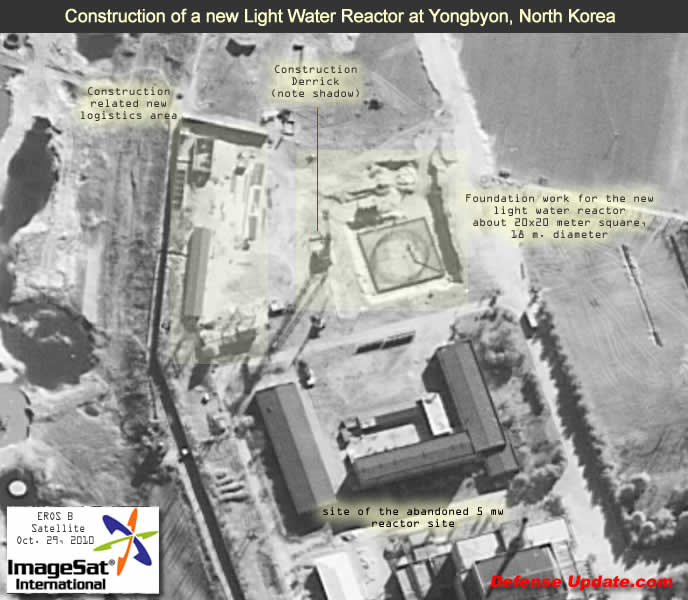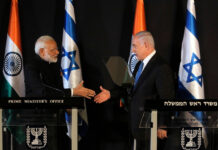
Reveal Construction Of Light Water Reactor, Uranium Enrichment Facilities At Yongbyon
The scope of the North Korean nuclear program is much larger than previously estimated by the west, as the North develops new nuclear capabilities at an alarming pace. In fact, Pyongyang is not trying to hide its activities, but openly invites U.S. nuclear scientists to witness the advanced state of the program, creating substential deterrence.

U.S. nuclear scientists invited to North Korea’s Yongbyon nuclear facility recently had the opportunity to witness the constrcution of a new light water reactor and new uranium enrichment facility accommodating thousands of centrifuges. One of the U.S. scientists, Jack Pritchard, a specialist on North Korea and retired US Army officer, reported upon his return the new reactor at Yongbyon, located near the location of the demolished cooling tower constructed to support the 5MW reactor constructed by the North in the 1990s. The site is visible in the image above, taken by the Israeli EROS B satellite on October 29, 2010.
“What they told us is that they are building a light-water reactor at Yongbyon,” Pritchard told reporters. “Physically, it is slightly in front of where the old cooling tower was located. We observed for ourselves the relatively early stage…” he said they were told North Korean wants to complete the construction of a 100-megawatt light-water reactor by 2012. This reactor will provide electricity for the immediate area of Yongbyon. The new facility was described as ‘experimental’. “They are trying to build on their own a relatively small light-water reactor to ensure that they can build one. If it is successful, from there, they intend to build a larger one.” Pritchard explained. A successful North Korean light water power reactor design could find a huge and ready market in Asia and Africa. While low enriched uranium cannot be used as weapon grade material, it can be further enriched to be used for weapons; it just takes longer and costs more to produce. But Albright said he thinks the program could be used to produce weapons-grade, highly enriched uranium. While North Korea already has tested two atomic bombs and produced other nuclear weapons, those were made from plutonium recovered from spent fuel harvested from a nuclear reactor, not from enriched uranium.
Lacking energy resources and pressed by international sanctions, North Korea is starving for energy and light water reactors which feed on low enriched uranium for fuel seem to be more accessible for the country.
Pritchard report confirmed earlier reports that appeared in 2010, about new construction at Yongbyon. Such reports were based on satellite imagery, and were unable to identify the nature and purpose of the construction. He estimated the size of the reactor being built at a 21-23 m’ to (70 to 75 ft) square and 18 m’ (“60 ft.) in diameter. The reactor is roughly one tenth the size that was originally being built at Kumho-Sinpo on the east coast of North Korea by the defunct, US and South Korean-backed Korean Peninsula Energy Development Organization (KEDO).
KEDO, a now-defunct international consortium, was established to oversee construction of two 1,000-megawatt light-water reactors in North Korea in exchange for Pyongyang’s nuclear freeze. It stopped the project in 2003 after the U.S. accused North Korea of running a clandestine uranium-based nuclear program. Up to that point, during the Bush administration, the North had honored its freeze of the reactor at Yongbyon for ten years; launched no ballistic missiles and detonated no nuclear tests.
The new reactor under construction is only part of Pyongyang’s revamped nuclear technology development. According to Robert Carlin, one of the three scientists visiting Yongbyon recently, the Yongbyon facility also includes a large uranium enrichment facility. “The North Koreans say it was 2,000 [centrifuges]. It was a lot.” said Carlin. “None of the experts that I knew predicted the North Koreans could build anything like this number… Everybody predicted they were at a very early stage,” Carlin said.
The centrifuges appear similar in design to those used at Natanz, the Iranian nuclear-fuel-production site, but North Korea described them as higher-efficiency machines. The new plant’s modernistic technology, rich collection of centrifuges and up-to-date control room, did not exist in the spring of 2009, just before international weapons inspectors were evicted from the country.
Diplomats and scientists alike largely agree that the latest developments are a game-changer. A military attack is unthinkable, but so is allowing a runaway nuclear program. In a report on the meeting, Carlin’s colleague Siegfried Hecker concluded: “The only hope appears to be engagement.” That means restarting stalled negotiations with North Korean leaders, whose hand appears to have been dramatically strengthened.
Right Photo: The Seattle Times reports: U.S. sees N. Korea plant as step toward nuclear arms. This photo combination of two satellite images shows, top, heavy construction equipment at the Yongbyon nuclear complex in North Korea on Sept. 29. 2010 The image from Nov. 4, 2010 bottom, shows a rectangular structure being built. Satellite Photos via AP.
Above: Danger Room reports the new uranium enrichment facility in Yongbyon has been built in barely a year, suggesting a big crash program to build more-powerful bombs than the plutonium ones currently in the North’s arsenal – even while United Nations sanctions against the North have grown more severe.

















